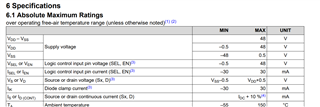Tool/software:
The datasheet calls it "Continuous current per channel"
Is that the supply current for VSS or VDD?
This thread has been locked.
If you have a related question, please click the "Ask a related question" button in the top right corner. The newly created question will be automatically linked to this question.
Tool/software:
The datasheet calls it "Continuous current per channel"
Is that the supply current for VSS or VDD?
Hi Lauren,
That's neither the supply current for VSS or VDD. Those are in the electrical characteristics table under IDD and ISS.
I_DC or "Continuous current per channel" is referring to the max current that can be passed through the switch. It's also called the "Source or Drain Continuous Current" in the datasheet.
The switch, when ON, acts as a passive low resistance pathway. The IDC spec tells us how much current can go through the pathway before we damage the switch.
Thanks!
Rami
Thanks Rami, but how is that different from I_S or I_D? Those also seem to represent the current that can be passed through the switch. I'm trying to understand for my customer because they're confused by the Abs Max table, when it says the max value for I_S or I_D is I_DC + 10%.
There is no difference.
As far as I can see, I_DC is a recommended operating condition.
Hi Lauren,
They are the same. I_DC gives the recommended condition. +10% to the I_DC is the abs max for what the switch can see.

But that doesn't make sense. On the abs max table it says the abs max value for I_S or I_D is I_DC + 10%. If you're saying I_S, I_D, and I_DC are the same currents, then the abs max value for I_DC is 10% above itself.
Please let me know if I'm missing something.
Hi Lauren,
I'm not sure where the confusion is here. Abs max will be above the recommended always.
Recommended is I_DC. Abs max is I_DC + 10%. So for example, for a 44V single supply 44V case at 25C the recommended is 330mA. The abs max would be 330 + 10% of 330 = 363mA.
-Rami
Oh yes, that makes sense now. Sorry it was just confusing how it's the same current but it's called 3 different things in the datasheet.
No worries, totally understand. It's done a little differently than how we usually spec our datasheets out.
Thanks!
Rami